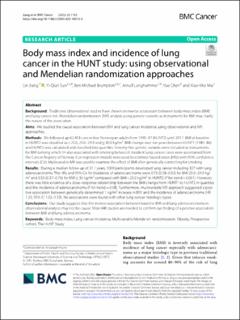| dc.contributor.author | Jiang, Lin | |
| dc.contributor.author | Sun, Yi-Qian | |
| dc.contributor.author | Brumpton, Ben Michael | |
| dc.contributor.author | Langhammer, Arnulf | |
| dc.contributor.author | Chen, Yue | |
| dc.contributor.author | Mai, Xiao-Mei | |
| dc.date.accessioned | 2023-02-02T09:15:15Z | |
| dc.date.available | 2023-02-02T09:15:15Z | |
| dc.date.created | 2022-11-09T13:34:46Z | |
| dc.date.issued | 2022 | |
| dc.identifier.issn | 1471-2407 | |
| dc.identifier.uri | https://hdl.handle.net/11250/3047908 | |
| dc.description.abstract | Background
Traditional observational studies have shown an inverse association between body mass index (BMI) and lung cancer risk. Mendelian randomization (MR) analysis using genetic variants as instruments for BMI may clarify the nature of the association.
Aims
We studied the causal association between BMI and lung cancer incidence using observational and MR approaches.
Methods
We followed up 62,453 cancer-free Norwegian adults from 1995–97 (HUNT2) until 2017. BMI at baseline in HUNT2 was classified as < 25.0, 25.0–29.9 and ≥ 30.0 kg/m2. BMI change over ten years between HUNT1 (1984–86) and HUNT2 was calculated and classified into quartiles. Seventy-five genetic variants were included as instruments for BMI (among which 14 also associated with smoking behavior). Incident lung cancer cases were ascertained from the Cancer Registry of Norway. Cox regression models were used to estimate hazard ratios (HRs) with 95% confidence intervals (CIs). Multivariable MR was used to examine the effect of BMI after genetically controlling for smoking.
Results
During a median follow-up of 21.1 years, 1009 participants developed lung cancer including 327 with lung adenocarcinoma. The HRs and 95% CIs for incidence of adenocarcinoma were 0.73 (0.58–0.92) for BMI 25.0–29.9 kg/m2 and 0.53 (0.37–0.76) for BMI ≥ 30 kg/m2 compared with BMI < 25.0 kg/m2 in HUNT2 (P for trend < 0.001). However, there was little evidence of a dose–response relationship between the BMI change from HUNT1 to HUNT2 in quartiles and the incidence of adenocarcinoma (P for trend = 0.08). Furthermore, multivariable MR approach suggested a positive association between genetically determined 1 kg/m2 increase in BMI and the incidence of adenocarcinoma (HR 1.25, 95% CI 1.02–1.53). No associations were found with other lung cancer histologic types.
Conclusions
Our study suggests that the inverse association between baseline BMI and lung adenocarcinoma in observational analysis may not be causal. More MR studies are needed to confirm our finding of a positive association between BMI and lung adenocarcinoma. | en_US |
| dc.language.iso | eng | en_US |
| dc.publisher | BMC | en_US |
| dc.rights | Navngivelse 4.0 Internasjonal | * |
| dc.rights.uri | http://creativecommons.org/licenses/by/4.0/deed.no | * |
| dc.title | Body mass index and incidence of lung cancer in the HUNT study: using observational and Mendelian randomization approaches | en_US |
| dc.title.alternative | Body mass index and incidence of lung cancer in the HUNT study: using observational and Mendelian randomization approaches | en_US |
| dc.type | Peer reviewed | en_US |
| dc.type | Journal article | en_US |
| dc.description.version | publishedVersion | en_US |
| dc.source.volume | 22 | en_US |
| dc.source.journal | BMC Cancer | en_US |
| dc.source.issue | 1 | en_US |
| dc.identifier.doi | 10.1186/s12885-022-10215-0 | |
| dc.identifier.cristin | 2071262 | |
| cristin.ispublished | true | |
| cristin.fulltext | original | |
| cristin.qualitycode | 1 | |

